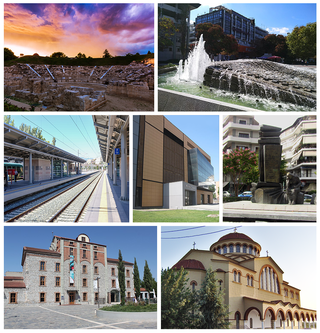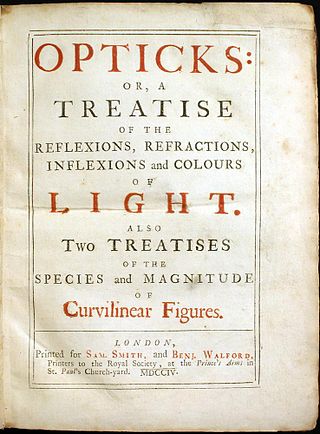Notes
| International | |
|---|---|
| National | |
| People | |
| Other | |
Heliodorus of Larissa (fl. 3rd century?) was a Greek mathematician, and the author of a short treatise on optics which is still extant.
Nothing is known about the life of Heliodorus. [1] He was a native of Larissa, [2] and he must have lived after the time of Claudius Ptolemy, whom he quotes. His short treatise on optics is little more than a commentary on Euclid. [3] It was edited by one Damianus, who was either his son or his pupil. [2] The first printed edition, in Greek and Latin, was published in Paris in 1657 with illustrative notes by Erasmus Bartholinus. [1]

Ḥasan Ibn al-Haytham was a medieval mathematician, astronomer, and physicist of the Islamic Golden Age from present-day Iraq. Referred to as "the father of modern optics", he made significant contributions to the principles of optics and visual perception in particular. His most influential work is titled Kitāb al-Manāẓir, written during 1011–1021, which survived in a Latin edition. The works of Alhazen were frequently cited during the scientific revolution by Isaac Newton, Johannes Kepler, Christiaan Huygens, and Galileo Galilei.

Larissa is the capital and largest city of the Thessaly region in Greece. It is the fifth-most populous city in Greece with a population of 148,562 in the city proper, according to the 2021 census. It is also capital of the Larissa regional unit. It is a principal agricultural centre and a national transport hub, linked by road and rail with the port of Volos, the cities of Thessaloniki and Athens. The municipality of Larissa has 164,095 inhabitants, while the regional unit of Larissa reached a population of 268,963.

Claudius Ptolemy was an Alexandrian mathematician, astronomer, astrologer, geographer, and music theorist who wrote about a dozen scientific treatises, three of which were important to later Byzantine, Islamic, and Western European science. The first was his astronomical treatise now known as the Almagest, originally entitled Mathematical Treatise. The second is the Geography, which is a thorough discussion on maps and the geographic knowledge of the Greco-Roman world. The third is the astrological treatise in which he attempted to adapt horoscopic astrology to the Aristotelian natural philosophy of his day. This is sometimes known as the Apotelesmatika but more commonly known as the Tetrábiblos, from the Koine Greek meaning "Four Books", or by its Latin equivalent Quadripartite.

Isaac Barrow was an English Christian theologian and mathematician who is generally given credit for his early role in the development of infinitesimal calculus; in particular, for proof of the fundamental theorem of calculus. His work centered on the properties of the tangent; Barrow was the first to calculate the tangents of the kappa curve. He is also notable for being the inaugural holder of the prestigious Lucasian Professorship of Mathematics, a post later held by his student, Isaac Newton.
Heliodorus is a Greek name meaning "Gift of the Sun". Several persons named Heliodorus are known to us from ancient times, the best known of which are:
Theon of Alexandria was a Greek scholar and mathematician who lived in Alexandria, Egypt. He edited and arranged Euclid's Elements and wrote commentaries on works by Euclid and Ptolemy. His daughter Hypatia also won fame as a mathematician.

Opticks: or, A Treatise of the Reflexions, Refractions, Inflexions and Colours of Light is a collection of three books by Isaac Newton that was published in English in 1704. The treatise analyzes the fundamental nature of light by means of the refraction of light with prisms and lenses, the diffraction of light by closely spaced sheets of glass, and the behaviour of color mixtures with spectral lights or pigment powders. Opticks was Newton's second major work on physical science and it is considered one of the three major works on optics during the Scientific Revolution.

Vitello was a Polish friar, theologian, natural philosopher and an important figure in the history of philosophy in Poland.

The Heliodorus pillar is a stone column that was erected around 113 BCE in central India in Besnagar (Vidisha), Madhya Pradesh. The pillar was called the Garuda-standard by Heliodorus (ambassador), referring to the deity Garuda. The pillar is commonly named after Heliodorus, who was an ambassador of the Indo-Greek king Antialcidas from Taxila, and was sent to the Indian ruler Bhagabhadra. A dedication written in Brahmi script was inscribed on the pillar, venerating Vāsudeva (krishna), the Deva deva the "God of Gods" and the Supreme Deity. The pillar also glorifies the Indian ruler as "Bhagabhadra the savior". The pillar is a stambha which symbolizes joining earth, space and heaven, and is thought to connote the "cosmic axis" and express the cosmic totality of the Deity.

Optics began with the development of lenses by the ancient Egyptians and Mesopotamians, followed by theories on light and vision developed by ancient Greek philosophers, and the development of geometrical optics in the Greco-Roman world. The word optics is derived from the Greek term τα ὀπτικά meaning 'appearance, look'. Optics was significantly reformed by the developments in the medieval Islamic world, such as the beginnings of physical and physiological optics, and then significantly advanced in early modern Europe, where diffractive optics began. These earlier studies on optics are now known as "classical optics". The term "modern optics" refers to areas of optical research that largely developed in the 20th century, such as wave optics and quantum optics.

Francesco Maurolico was a mathematician and astronomer from the Kingdom of Sicily. He made contributions to the fields of geometry, optics, conics, mechanics, music, and astronomy. He edited the works of classical authors including Archimedes, Apollonius, Autolycus, Theodosius and Serenus. He also composed his own unique treatises on mathematics and mathematical science.

The Opus Majus is the most important work of Roger Bacon. It was written in Medieval Latin, at the request of Pope Clement IV, to explain the work that Bacon had undertaken. The 878-page treatise ranges over all aspects of natural science, from grammar and logic to mathematics, physics, and philosophy. Bacon sent his work to the Pope in 1267. It was followed later the same year by a smaller second work, his Opus Minus, which was intended as an abstract or summary of the longer work, followed shortly by a third work, Opus Tertium, as a preliminary introduction to the other two.

The Aethiopica or Theagenes and Chariclea is an ancient Greek novel which has been dated to the 220s or 370s AD. It was written by Heliodorus of Emesa and is his only known work.

A treatise is a formal and systematic written discourse on some subject concerned with investigating or exposing the principles of the subject and its conclusions. A monograph is a treatise on a specialized topic.
Domninus of Larissa was an ancient Hellenistic Syrian mathematician.
Charmadas was a Greek academic skeptic philosopher and a disciple of Carneades at the Academy in Athens. He was famous for his elegant style. Charmadas introduced the teaching of rhetoric into the Academy and is said to have had many students. He was a pupil of Carneades for seven years and later he led his own school in the Ptolemaion, a gymnasium in Athens. He was from Alexandria and seems to have lived there, before he went to Athens around 145 BC He was an excellent rhetorician and famous for his outstanding memory and for his ability to memorize whole books and then recite them. Like Philo of Larissa he seems to have pursued a more moderate philosophical scepticism. Lucius Licinius Crassus and Marcus Antonius (orator) were his most prominent pupils. Furthermore, Philodemus preserved us the names of other pupils: Diodorus of Adramyttion, Apollodor of Tarsus, Heliodorus of Mallos, Phanostratus of Tralles and a certain Apollonius.

This is a timeline of mathematicians in ancient Greece.
The gens Avidia was an ancient Roman family that flourished during the early centuries of the Empire. Several of its members rose to prominence during the late first and second centuries AD.
The Spherics is a three-volume treatise on spherical geometry written by the Hellenistic mathematician Theodosius of Bithynia in the 2nd or 1st century BC.